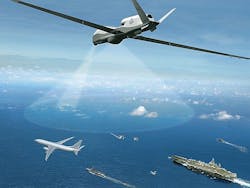MQ-4C Triton pioneers sense-and-avoid radar that could help other UAVs fly in civil airspace
THE MIL & AERO BLOG, 23 June 2015. The U.S. Navy Northrop Grumman MQ-4C Triton maritime patrol drone is helping to pioneer the ability of unmanned aircraft to sense and avoid nearby airplanes autonomously to avoid mid-air collisions and other complications of aircraft flying in close proximity.
The Navy last week awarded a $39.1 million contract to Northrop Grumman, the Triton's designer, to make enhancements to the unmanned aerial vehicle (UAV) air-to-air radar system in preparation for production decisions over the next few years.
The Navy and Northrop Grumman are developing the MQ-4C Triton, also called the Broad Area Maritime Surveillance (BAMS) UAV, to fly maritime surveillance missions for as long as 24 hours at altitudes of more than 10 miles to enable coverage out to 2,000 nautical miles.
In addition to the Triton's air-to-air sense-and-avoid radar capability, the UAV's suite of surface-search radar and electro-optical sensors can detect and classify different types of ships automatically.
Related: Northrop Grumman to fix MQ-4C Triton UAV air-to-air radar before Navy production decision
In addition to long-range maritime surveillance missions, the Triton is being designed to work together with the Navy's P-8A Poseidon manned maritime patrol aircraft to detect, pinpoint, and attack enemy submarines. The P-8 is a Boeing 737 passenger jet modified for surveillance and anti-submarine warfare (ASW) missions.
If any kind of UAV needs sense-and-avoid radar, it's the Triton. The large whale-shaped UAV -- a maritime-patrol version of the U.S. Air Force Northrop Grumman RQ-4 Global Hawk -- has to cover vast ocean areas in its search for enemy submarines, pirates, drug smugglers, and the like.
Its range and altitude will be longer and higher than all but a few manned surveillance aircraft, and often the Triton will be operating largely on its own.
Funding and technical problems have stretched out development of the Triton's sense-and-avoid radar. This air-to-air radar design is the first of its kind, and Northrop Grumman and radar partner Exelis in McLean, Va., have struggled to keep the system small and lightweight enough for the Triton while maintaining the capabilities that the Navy needs.
Making sure the Triton's sense-and-avoid radar capability works according to requirements should be worth the time and expense, as this design also could be applied to other UAV designs to enable them to see and avoid other aircraft.
The ability to see and avoid is a fundamental require of all manned and unmanned aircraft. This is an essential capability especially for aircraft expected to operate in controlled and congested airspace.
The ability for unmanned aircraft to operate safely side-by-side with other drones as well as with commercial, military, and general-aviation aircraft will be a major step toward integrating unmanned aircraft in to the National Airspace System for commercial and private use.
The UAV sense-and-avoid technologies that the Navy, Northrop Grumman, and Exelis are pioneering with the Triton could go a long way toward realizing this goal.


